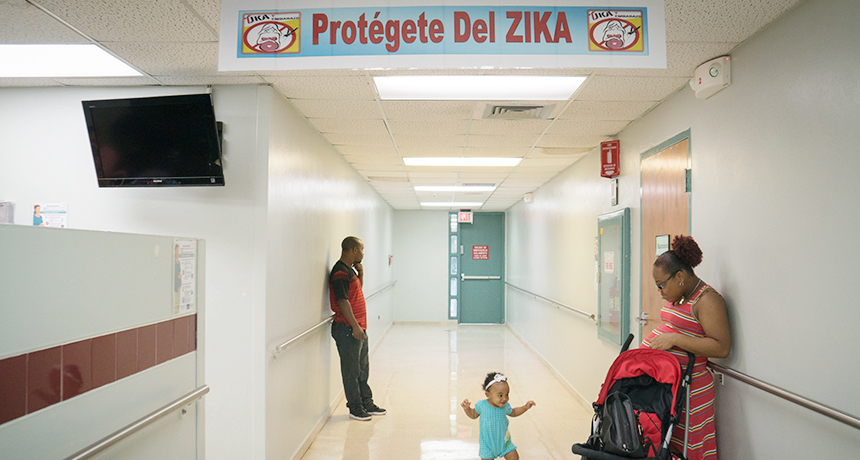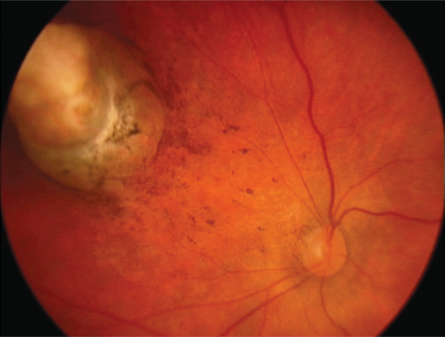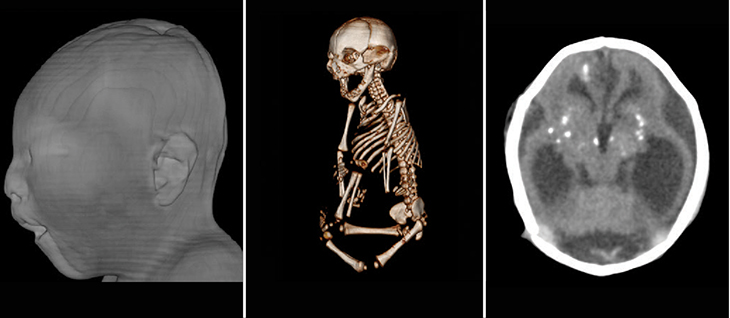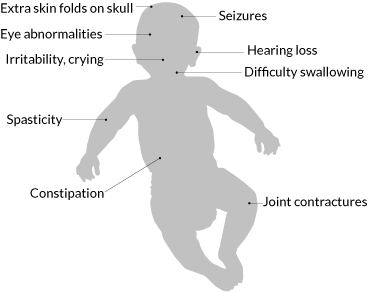Concern expands over Zika birth defects
Besides microcephaly, virus could cause long-term health problems

ON EDGE A pregnant woman and her family wait at a health clinic in Loiza, Puerto Rico. The U.S. territory has been hit hard by Zika virus, and nearly 2,000 pregnant women have been confirmed as infected.
Angel Valentin/Getty Images
After a year caring for patients at the heart of Brazil’s Zika epidemic, pediatric neurologist Vanessa van der Linden has seen some of the worst cases.
She was one of the first researchers to link Zika virus to microcephaly, a now well-known birth defect marked by a small, misshapen head and, sometimes, a forehead that slopes backward. Babies with the defect can have other symptoms, too: Van der Linden has seen 24-hour crying bouts, spasms, extreme irritability and difficulty swallowing.
But microcephaly is just the tip of the Zika iceberg, she said September 22 at a workshop hosted by the National Institutes of Health in North Bethesda, Md. That’s something public health officials have been warning about for months. Now, scientists have begun to describe a head-to-toe assortment of health problems linked to Zika virus infection in utero; they’re calling it congenital Zika syndrome.
Still, the full scope of the problem, including the threat of more subtle neurologic disorders such as learning disabilities or developmental delays, remains murky, says Peter Hotez, a pediatrician and microbiologist at Baylor College of Medicine in Houston.
“That’s the big unknown: There’s probably a spectrum of illness,” similar to autism, he says. And it could take years for scientists to sort it all out.
It’s a problem that Brazil is facing now, and one that Puerto Rico has just begun grappling with.
As of September 23, the U.S. territory had reported 22,358 confirmed cases of Zika infection. Of these cases, 1,871 are pregnant women. Carmen Zorrilla, an obstetrician-gynecologist at the University of Puerto Rico’s Maternal-Infant Studies Center who has examined some of these women and their babies, emphasizes the importance of following up on all babies exposed to Zika in the womb — even those without apparent birth defects.
“Even if they are born normal,” she said, “it doesn’t mean they’ll be OK.”
Insidious problems
At the workshop, Zorrilla described the case of one of the first Puerto Rican babies born to a mother diagnosed with Zika. The baby didn’t have microcephaly, but she did have another unusual problem: She couldn’t open her eyes. A bad case of conjunctivitis (pinkeye) left her needing help opening her eyelids every morning — even 27 days after birth.

Zorrilla can’t say for sure whether the problem was related to Zika, but “it really concerned me,” she said. “This is the first baby I’ve seen with conjunctivitis that lasted for so long.”
The case may be another clue that Zika’s assaults on the body are widespread. And Zorrilla can expect to see more cases soon. Ultrasound examinations of 228 women in Puerto Rico with confirmed Zika infection have spotted brain abnormalities in 13 fetuses, including one with microcephaly.
Another observation could hint at problems yet to come: Most of the Zika-exposed fetuses tended to have slightly smaller heads than average, although “still within the normal limits,” Zorrilla said. But measurements of leg bones and stomach size indicate that the rest of the body is growing normally. Implications remain unclear, but the findings — preliminary results from Alberto de la Vega, also an obstetrician-gynecologist at the University of Puerto Rico — are the latest in a litany of anomalies linked to Zika.
Long-term problems aren’t unusual in babies infected with a different kind of virus that causes microcephaly. Like Zika, cytomegalovirus can infect babies in the womb. Most CMV-infected babies don’t have any obvious symptoms, but asymptomatic kids may have problems as they grow, including intellectual disabilities, hearing loss or cerebral palsy, researchers suggested in the October Brain and Development.
Beyond microcephaly, scientists have recently described other symptoms linked to Zika infection. In some babies, for example, Zika seems to damage hearing. Of 70 Zika-exposed infants born with microcephaly, 10 percent had some hearing loss, researchers noted in a Sept. 2 report published by the U.S. Centers for Disease Control and Prevention.

Zika can leave a mark on the eyes, too. More than a third of 29 babies with microcephaly had some sort of eye oddity, including mottled pigmenting and withered tissue, researchers reported in May in JAMA Ophthalmology.
Van der Linden has also observed a link between Zika and a deformity called arthrogryposis, where a child’s joints can be stuck in contorted positions — even in babies without microcephaly. The condition might stem from problems with infected babies’ motor neurons, the nerve cells that relay messages from the brain to the muscles, van der Linden and colleagues suggested August 9 in BMJ.
She has even seen babies born with normal head circumferences who later develop microcephaly or other brain defects. One mother, she says, came in five months after giving birth because she thought her baby wasn’t developing normally. Like children with congenital Zika syndrome, the baby’s head scans revealed “the same pattern of brain damage,” van der Linden says. This pattern includes a malformed cerebral cortex, the wrinkled outer layer of the brain, and calcifications, strange lumps of calcium deposited within the tissue.
Infiltrating the brain
Scientists still don’t know exactly how Zika damages the brain, but they have some ideas.
One recent report found that the virus can infiltrate and kill both neuroepithelial stem cells, which give rise to all sorts of brain cells, and radial glial cells, which can generate newborn neurons and help guide them to their proper place in the brain.
Zika also hinders these cells’ ability to split into new cells, Yale University neuroscientist Marco Onorati and colleagues reported September 6 in Cell Reports.
Stem cells at work in the fetal brain eventually give rise to structures responsible for thought and memory and learning, raising concerns of a cascade of problems down the road. “This is a virus that blocks the development of the fetal brain,” Hotez says. “That’s about the worst thing you can possibly imagine.”
And fetuses might not be the only ones at risk, he points out. “Kids in the first years of life also have growing, developing brains,” he says. “What if they get infected with Zika?”
It’s not an easy question to answer. But another disease could offer clues.
Malaria, for example, can cause severe neurological problems. In children, a condition called cerebral malaria may be linked to mental health disorders such as attention-deficit/hyperactivity disorder, antisocial behavior and depression, researchers reported in March in Malaria Journal.
Researchers will also need to watch out for long-term troubles in Zika-exposed babies born with no obvious symptoms, says the CDC’s Sonja Rasmussen. “We don’t want to make families too scared,” she says. “But we do recognize the possibility of later-on seizures or developmental delay.”
Since most people don’t show signs of Zika infection, pinpointing the total number of pregnant women (and babies) exposed to the virus may be impossible.
In the Americas, at least, the number is probably enormous. Tens of thousands of children may eventually suffer some sort of neurologic or psychiatric illness triggered by Zika, Hotez predicted in a paper published in JAMA Pediatrics in August.
Van der Linden can’t say whether the babies she has seen have learning disabilities or psychiatric illnesses, or other more subtle cognitive problems — most of her patients are between 9 months and 1 year old.
But she plans to follow these patients, and the babies who appeared normal at birth, for years. “We need time to better understand the disease,” she says.
Hotez agrees: “It’s going to take a generation of pediatric neurologists and infectious disease experts to figure this out.”
Editor’s note: This story was updated October 6, 2016, to correct the incidence of hearing loss in a study of children born with microcephaly.








